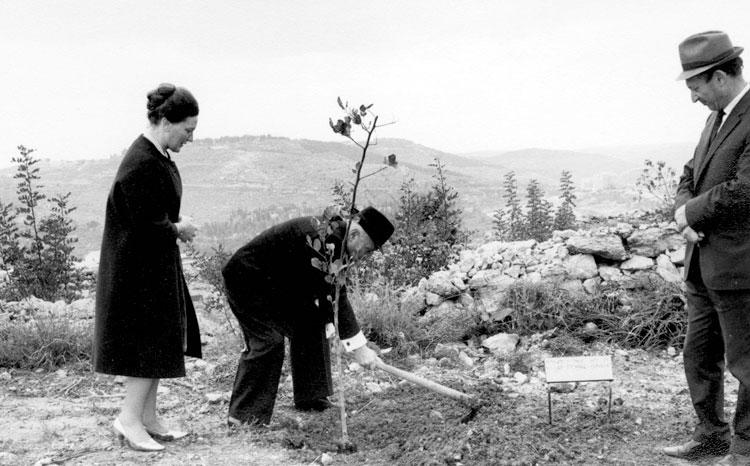Prepared by Dr. Joanna Sliwa
The Term
The Hebrew term for the Righteous Among the Nations, Hassidei Umot Haolam originates from Jewish religious texts. This phrase denotes virtuous, pious, and wise gentiles (non-Jews). Since 1963, the term has been used as an honorific to recognize the courage, selflessness, and risks of non-Jews who saved the lives of Jews during the Holocaust.

The Recognition
In the first years after World War II, Jewish organizations, such as the American Jewish Joint Distribution Committee (known as the JDC or the Joint) and the World Jewish Congress, issued payments to select non-Jewish rescuers at the request of Jewish survivors. This was a need-based and informal initiative. In 1953, the State of Israel introduced the Martyrs’ and Heroes’ Remembrance Law which established Yad Vashem. The law tasked the new institution with honoring and documenting the sacrifice and heroism of non-Jews who risked their lives to rescue Jews during the Holocaust. In 1963, a commission was established to review applications and confer awards.
The Process
The process of reviewing applications for the title has evolved over the years. Today, the Department of the Righteous Among the Nations at Yad Vashem compiles necessary evidence about a submitted story of rescue. It then forwards the case to the Commission for the Designation of the Righteous, which is chaired by a retired justice of the Israeli Supreme Court. Committee members determine the plausibility of the rescue story and corroborate it with documents submitted by and about the rescuer and survivor and weigh it against additional research and historical information. Following the assessment of the case, deliberations, and voting, the decision is evaluated by the committee chairperson. The resolution is final.
The Criteria
According to the definition for the purpose of the Righteous Among the Nations Award, a Righteous is a non-Jew who risked his or her life to save Jews. Four primary criteria guide the process: actively saving a Jewish person, facing risks, refraining from seeking or receiving renumeration as a precondition for assistance, and presenting relevant proof of rescue. The title can be bestowed to a living person or posthumously. No deadline exists on submitting a petition.
Recipients of the Righteous Among the Nations designation are recognized with a special personalized minted medal and a certificate of honor. They also receive honorary citizenship of the State of Israel, or a commemorative citizenship if the award is given posthumously. Ceremonies are organized in an awardee’s country of residence. This is a public and dignified affair in the presence of members of Israel’s diplomatic corps.
Until 1990, trees in honor of the Righteous were planted by the Righteous themselves (who were invited to visit Israel to receive their award) or by their relatives, and some were planted by survivors. Each tree is marked a plaque with the name of the Righteous and his or her country of origin. The first eleven trees were planted at the dedication of the Avenue of the Righteous Among the Nations at Yad Vashem that took place on Yom HaShoah (Holocaust Remembrance Day) on May 1, 1962. When space for new tress was exhausted, Yad Vashem dedicated a memorial wall. The plaques commemorate the names of over 25,000 rescuers.

The Meaning
The introduction of the Righteous Among the Nations title is a way for the Jewish people to pay tribute to the immense bravery of non-Jews who were ready to risk their professional and social positions, personal freedoms, and even their lives to protect Jews during the Holocaust. It is meant to record and commemorate the actions of the individuals who chose to help the oppressed Jews. The legacy of the Righteous carries a powerful message rooted in the Talmud (the written collection of ancient teachings regarded as sacred and normative by Jews): “Whoever saves one life, saves an entire world.”

As of January 1, 2021, there have been 27,921 rescuers recognized by Yad Vashem as Righteous Among the Nations. The largest number with 7,177 belongs to Poland. The country had the largest Jewish population in Europe in September 1939 – about 3.3 million Jews, or 10% of the population. Out of this number, about 300,000 Jews survived, with approximately 200,000 in the Soviet Union. This meant that 90% of Poland’s Jews were murdered during the Holocaust. The example of Poland also applies to other countries to show that rescue was the exception and not the norm.
The numbers of recognized Righteous persons reflect the strict criteria for the designation. Then too, not all eligible histories of rescue are known or will ever be known. Some rescuers, including family members of Jews whom they rescued, objected to the application being submitted on their behalf. The way they saw it, they were simply protecting their loved ones. Other people refused the award because they did not consider their actions extraordinary; they did what, to them, was a decent, humane thing to do. Some rescuers were hesitant to make their wartime actions public for fear of ostracism in their communities. There are cases when survivors do not know the names of their rescuers or have waited to nominate their aid givers for other reasons.
The Role of the Claims Conference
The Conference on Jewish Material Claims Against Germany (Claims Conference), which had been created in 1951, was the first to acknowledge the moral obligation to non-Jews who had risked their lives to save Jews during the Holocaust and who were now in need themselves. In 1963, the Claims Conference established the Hassidei Umot Haolam Program to issue pensions to eligible Righteous persons. Since the program’s inception, the Claims Conference has supported 784 Righteous Gentiles recognized by Yad Vashem. Between 2001 and 2019, the Jewish Foundation for the Righteous administered the payments. As of 2020, the Righteous Gentiles program is funded directly through the Claims Conference.
